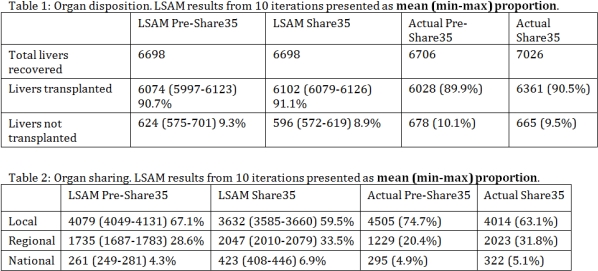Historical Comparison of Projected and Observed Liver Transplants
1SRTR, Minneapolis Medical Research Foundation, Minneapolis, MN
2Surgery, Johns Hopkins University School of Medicine, Baltimore, MD
3Mathematics, US Naval Academy, Baltimore, MD
4Medicine and Surgery, University of Minnesota Medical School, Minneapolis, MN
5School of Medicine, Stanford University, Stanford, CA.
Meeting: 2015 American Transplant Congress
Abstract number: C110
Keywords: Liver transplantation, Outcome, Public policy, Waiting lists
Session Information
Session Name: Poster Session C: Liver Donation and Allocation
Session Type: Poster Session
Date: Monday, May 4, 2015
Session Time: 5:30pm-6:30pm
 Presentation Time: 5:30pm-6:30pm
Presentation Time: 5:30pm-6:30pm
Location: Exhibit Hall E
We aimed to compare liver transplant simulation projections to observed data before and after a major policy update. The current liver simulated allocation model (LSAM 2014) was used to simulate 1 year of liver transplants under rules from before and after implementation of Share35, which added full regional sharing for candidates with model for end-stage liver disease (MELD) scores of 35 or above. Results of these simulations were compared with actual data from SRTR's standard analysis files for the 1-year periods immediately before and after Share35 implementation on June 18, 2013. LSAM projected a minor decrease in rates of livers recovered for transplant but not transplanted (from 9.3% to 8.9%) and a decrease was observed in the actual data (from 10.1% to 9.5%, Table 1). LSAM overestimated the proportion of livers shared regionally under the pre-Share35 rules (28.6% regional sharing in LSAM vs. 20.4% observed) but correctly projected that regional sharing would increase under Share35 (33.5% projected vs. 31.8% observed, Table 2).  LSAM projected an increase in transplant rates for MELD 35+ candidates from 862 to 1258 transplants per 100 patient-years, and an increase from 1085 to 1478 was observed. Finally, LSAM projected a slight decrease in waitlist death rates for MELD 35+ candidates from 105 to 100 deaths per 100 waitlist years and a decrease from 157 to 143 was observed. Implementation of Share35 presents a rare opportunity to evaluate LSAM projections against observed data across a policy-change boundary. LSAM correctly predicted the direction of change in most outcome categories of interest, although the magnitude of some changes was smaller than observed.
LSAM projected an increase in transplant rates for MELD 35+ candidates from 862 to 1258 transplants per 100 patient-years, and an increase from 1085 to 1478 was observed. Finally, LSAM projected a slight decrease in waitlist death rates for MELD 35+ candidates from 105 to 100 deaths per 100 waitlist years and a decrease from 157 to 143 was observed. Implementation of Share35 presents a rare opportunity to evaluate LSAM projections against observed data across a policy-change boundary. LSAM correctly predicted the direction of change in most outcome categories of interest, although the magnitude of some changes was smaller than observed.
To cite this abstract in AMA style:
Pyke J, Schladt D, Kim W, Leppke S, Lake J, Gentry S, Segev D, Israni A, Snyder J. Historical Comparison of Projected and Observed Liver Transplants [abstract]. Am J Transplant. 2015; 15 (suppl 3). https://atcmeetingabstracts.com/abstract/historical-comparison-of-projected-and-observed-liver-transplants/. Accessed December 19, 2025.« Back to 2015 American Transplant Congress
